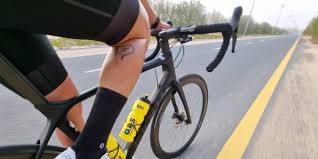In professional cycling, where races stretch over hours and riders push their bodies to the edge of endurance, the difference between finishing strong and fading fast can come down to something as simple and as complex water. Hydration isn’t just important in this sport. It’s vital.
The Demands of the Road
Professional cyclists can spend 4 to 6 hours in the saddle during races like the Tour de France, burning thousands of calories and sweating out liters of fluid—even in cooler conditions. On hot stages, riders may lose more than 2% of their body weight through sweat. That might not sound like much, but in the world of elite performance, it’s huge.
Even mild dehydration (as little as 1–2%) can lead to:
- Decreased endurance
- Slower reaction times
- Poor temperature regulation
- Muscle cramps
- Mental fatigue
In a sport where tactics, timing, and precision are everything, there’s simply no room for errors caused by something preventable.
What’s in the Bottle Matters
Hydration in cycling isn’t just about replacing water it’s about maintaining electrolyte balance, especially sodium, potassium, and magnesium. These minerals help regulate muscle function, nerve signals, and fluid balance. That’s why you’ll rarely see a pro cyclist drinking just plain water mid-race.
Instead, bottles are often filled with carbohydrate-electrolyte solutions, specially designed to:
- Rehydrate quickly
- Replenish lost salts
- Deliver a steady energy boost
Some riders even switch bottles depending on the race phase starting with higher-carb mixes for energy early on, then moving to more electrolyte-focused drinks as sweat loss builds up.
Pre-Loading and Rehydration: It Starts Before the Start Line
Top cyclists don’t wait until they’re thirsty. Hydration starts before the race begins. In the 24-48 hours leading up to a race, athletes carefully manage fluid intake to ensure they’re fully topped off. This often includes:
- Drinking consistently throughout the day
- Adding electrolytes to water
- Monitoring urine color as a hydration cue
Post-race, the focus shifts to recovery. Rehydrating isn’t just about replacing fluids it’s also crucial for muscle repair, glycogen restoration, and preventing next-day fatigue.
The Tech Behind the Hydration
Modern cycling teams use data to stay ahead. Sweat rate tests, sodium loss analysis, and body weight tracking before and after rides all inform custom hydration strategies for each rider. No two riders sweat the same so hydration plans are now tailored to individual physiology, weather, terrain, and even race intensity.
Some riders even use real-time hydration sensors, helping coaches make in-race decisions from the team car.
Final Sprint
Hydration in professional cycling is as strategic as it is scientific. It’s no longer just about grabbing a bottle from the team car it’s a carefully managed performance variable. In a sport where races are won by seconds, staying hydrated can be the edge that gets a rider to the podium or the reason they don’t make it at all.

